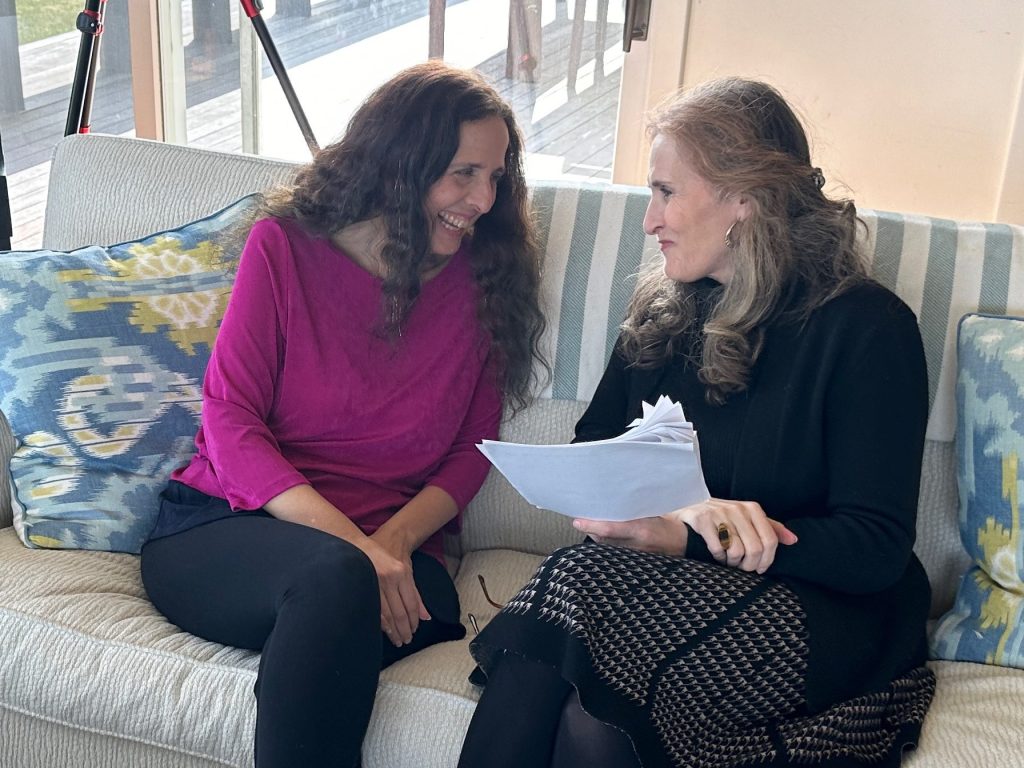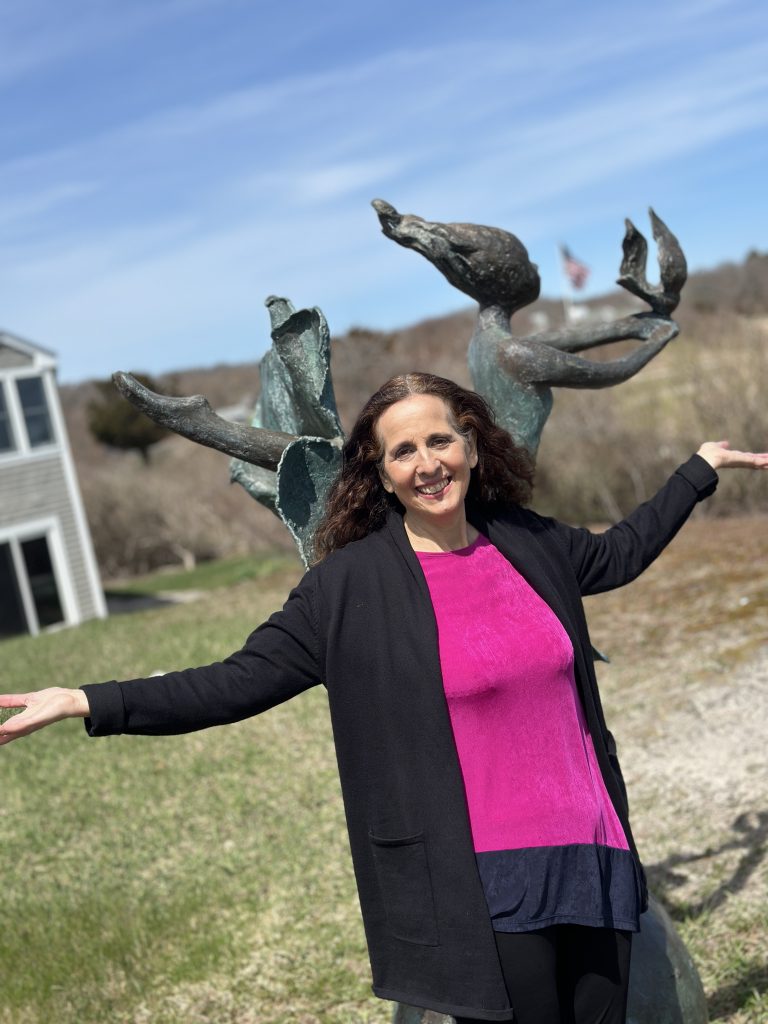For the past three weeks, I’ve been swept up in a whirlwind of activity and teamwork creating all the special interactive tools and accompanying video and audio for my upcoming book.
Speaking of which, and forgive me if you’ve heard this before, but please schedule the book purchase and party for June 12 at noon ET, 9 am PT in your calendar now so you can join us for a fabulous book launch party (giveaways, bonuses, special training, celebration!).

I have learned so much in these three weeks of working with extraordinary individuals who are helping me create something truly special and empowering for you as a writer and creative. So, today, here are some of the big picture and nitty-gritty details of what I’ve learned from digital media pro Dan Thibeault of Fast Twitch Media and producer Portland Helmich regarding recording audio and video content.
Readers of The Joy of Writing Journal may remember the QR codes that lead to interactive video content and audio meditations/visualizations. My new book takes this a step further with a dozen audio meditations and breathing practices and ten videos that teach you simple qigong, yoga, sufi spinning and other ancient wisdom practices reimagined to induce creative flow for your writing. Hold onto your seat—it’s life-changing!
Without further ado, here are some of the lessons learned and tips to share.
Lessons in Shooting and Recording Video
Scene: You want to find an interesting background that has some depth to it. Not clutter but depth. So have an object or two behind you and the wall for example. (Thank you, Portland!). And Dan advises, “Spaces before faces,” meaning, “choose your environment before you start, ensuring there is enough room for various effects.”

Noise: Shooting indoors is simpler than outdoors. You have fewer noises to contend with (think airplanes, traffic and even birdsong, if it may interfere with your spiel). While the audio engineer may be able to take out some of the noises, it’s much easier and more reliable to eliminate what noise you can from the outset.
Indoors can be noisy too. Turn off any heat that blows and makes noise, fans, etc. Be alert for a loud refrigerator!
Mics: On a related note, we used a wireless Lavalier mic, which was great overall, but with a particular outfit, when I did any twisting movements (in the qigong or yoga practices), my blouse material slid near the mic and made a loud annoying sound. Our solution was to shoot the two twisting videos without sound and add the verbal instruction separately. All the other videos we could shoot with sound from the outset.
Make-up: It helps. If you’re not used to applying make-up, get professional help or a lesson. I’m not a big makeup person, but I could see the difference in appearance on camera when I added makeup. Portland did an amazing job and she taught me well enough that when I was on my own for my photo shoot, I applied foundation, mascara and eyeliner, in addition to powder, eyebrow pencil, lipstick and blush. For most of my female readers, you are probably way more advanced than I am, but this was valuable for me.
Dressing: Wear something flattering. Boxy clothes that may look fine in real life often look extra bulky on camera. Materials like acetate or silk that have a flowing quality can be more forgiving than the natural fibers I prefer in IRL. Solid colors can be more attractive and less distracting. Find out what colors look best on you.
Lessons in Shooting and Recording Audio Content
Everything in this section, I credit to Dan Thibeault. Dan got online with me and coached me as we practiced and then recorded audio. His tips:

- Read slowly. Especially for a meditation! Let your listeners hear every word clearly.
- Modulate your voice with variety.
- Start with a lower register if you tend to have a high voice. For me, this meant consciously relaxing my body/mind and especially my throat muscles.
- Breathe from the diaphragm. Oh, yeah, always, but especially if you’re teaching breathing exercises, Lisa! This tip will also help you instantly do the next bullet item.
- Relax. When you relax, your listeners will.
- Smile. This comes across in audio as well.
- Have a high-quality mic. I use FiFine, and I love it. I did discover last year that occasionally, the wire plug falls out of the bottom, and at first, I could not figure out why it stopped working. So do keep an eye on that. It’s a rare issue and an easy fix if you know what is going on.
- Dan also had me buy a pop filter for my mic. It’s a simple device that places a nylon fabric between your mic and your mouth so that you don’t get those popping sounds (from the air you release) when pronouncing b’s and p’s. It was less than ten bucks and makes a world of difference.
- Dan also advised me for video and audio to avoid dairy as it can be mucoid forming. Good call!
- Another Dan tip: hydrate!
- Record with headphones on.
- Record in stereo.
I have to admit, Dan got me to relax easily on our first audio, but when I began practicing I found my throat tightening up and wondered how on earth I would be able to record even a single audio without losing steam.
How to Relax Your Voice for Recording Audio and Video
For that, I did some online research here, here and here to find out how to relax my throat and prepare. Here’s the list I made after the research:

- Hydrate – warm water, green apples (pectin)
- Relax your shoulders, sit up straight and breathe from deep in your belly (diaphragmatic breathing).
- If your mouth gets dry, use moist air and/or take breaks to inhale steam.
- Massage your facial muscles and throat.
- Drink warm liquids.
Sounds to make:
- MMMMMM – up and down the scale
- Hmmmm – an octave lower than usual
- Buzz – purse lips and buzz
- Trill – tongue behind top teeth, vibrate your tongue in the sound of r
- Nay nay nay – ditto (and repeat with e and so and me)
I also remembered Portland’s advice from making videos. She had told me to look into the camera and imagine the audience—speak to them. I did this with the audios as well—no camera, but imagining that I was speaking directly to my readers and listeners.
What to Program to Use for Recording Audio
I recorded audio using free open-sourced software called Audacity and found this video quite helpful. Some of the tips I used included:
- Record in stereo.
- Choose 48,000 hz (not the default).
- Set volume around .89.
Now that the videos are shot, Dan is working his magic and I am warming up to recording audio meditations and visualizations. Stay tuned for more lessons on the book writing and publishing path!
Share any questions or comments about recording video and audio and I’ll ask our experts, Dan and Portland, to weigh in.

